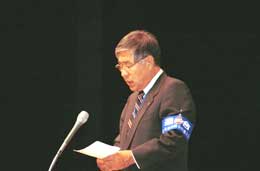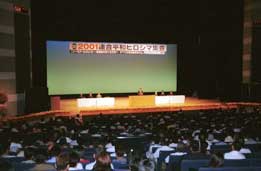| Strengthen Peace Movements
at Workplaces and by Region 2001 RENGO Peace Rally at Hiroshima/Nagasaki (24 August 2001) |
||||
|
It has been 56 years since they were first exposed. This was the first anniversary ceremony for Hiroshima and Nagasaki held in the 21st century. As in previous years, RENGO set aside August 3rd to the 9th as "RENGO Nationwide Peace Week" in order to conduct peace movements all over the country in conjunction with affiliated organizations and local RENGO. RENGO held the "2001 RENGO Peace Rally in Hiroshima" on the 5th at Hiroshima's Kosei Nenkin Kaikan Hall, and its "2001 RENGO Peace Rally in Nagasaki" on the 8th at the Nagasaki City Civic Auditorium, with approximately 3000 and 2000 attendees each. All of the participants renewed their vow to make this century "one without nuclear weapons and war, but dialogue and peace."
The 2001 RENGO Peace Rallies in Hiroshima/Nagasaki were organized by
RENGO in cooperation with the Japan Congress Against Atomic and Hydrogen
Bombs (GENSUIKIN) and the National Council for Peace and Against Nuclear
Weapons (KAKKIN), under the main slogan of "No More Hiroshima/
Nagasaki. Tell the World of the Anger of the Atom-bomb Victims. Abolish
All Nuclear Arms and Build a Peaceful 21st century!" Representing the organizers at both rallies, RENGO President Washio poured his soul into singing Shinda Onna no ko (a Dead Little Girl) written by Koji Kinoshita, the composer of Genbaku Yurusumaji (Never Forgive Atomic Bomb). Shinda Onna no ko is a song about the feelings of a six-year old girl who lost her life to the Atomic bomb. President Washio said with a break in his voice, "this little six year old girl left this world without ever having the chance to eat delicious sweets. Such a thing should never allowed to be repeated again." At the Hiroshima Rally held on August 5, RENGO Hiroshima President
Morikawa greeted participants in his opening statement by saying, "we
will continue to create peace movements with newer, broader content
that many people throughout the world can join." Following that,
a prepared message from Hiroshima Prefectural Governor Fujita and Hiroshima-city
Mayor Akiba was read. It stated, "We should court international
public opinion that seeks the total abolition of nuclear weapons and
continue our efforts to change nuclear nations' policies by extending
the circle of solidarity across national borders and through our cities
and citizens." At the Nagasaki Rally on August 8, Nagasaki Governor Kaneko and Nagasaki Mayor Ito attended the rally which opened with singing by a local children's choir. RENGO Nagasaki President Kamitani gave a speech saying "we will continue to tell the real facts of being A-bombed to the next generation as well as sending out information on peace to the all people on the planet." Mayor Ito said "the world knows so too little about how horrible the atomic bombs and radiation really are. We will tighten our grip on the peace movements and carry on." Further, the Peace Caravan established by RENGO Headquarters, RENGO Hiroshima and RENGO Nagasaki was introduced. The Caravan reported that it appealed for the abolition of atomic weapons and the dignity of peace on the streets as it moved from Hiroshima to Yamaguchi, Fukuoka and Nagasaki. The Caravan called for attendees to "extend the nuclear weapon abolition movement after you return to your workplaces/local areas." Then, High School Student Peace Ambassadors talked about their thoughts on peace. "We can still learn from the past even if you have not experienced war and were not victims. What is important is that one of us learns on our own and thinks about it." Jazz musician Haru held a Peace Concert where all the attendees sang Genbaku Yurusumaji together along with other songs. |

